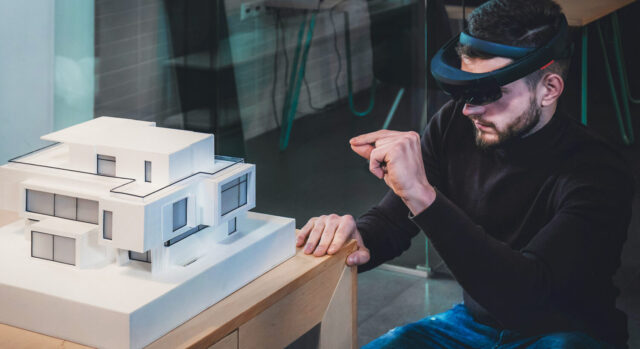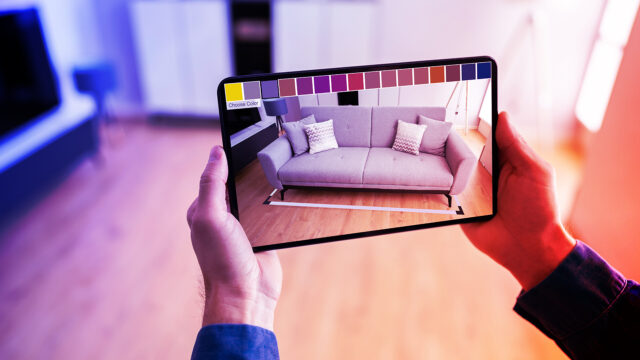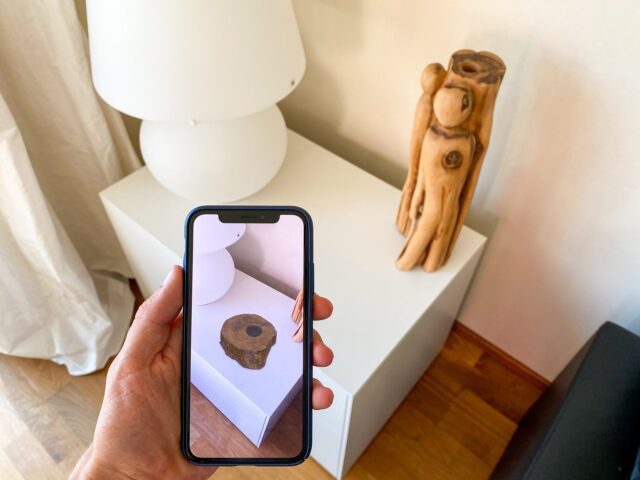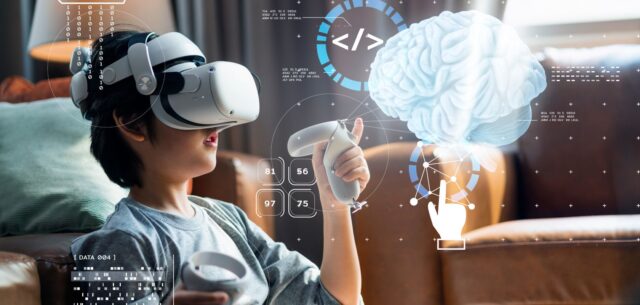
Augmented reality (AR) has revolutionized design visualization, providing an effective means for connecting abstract ideas with tangible visualizations for greater comprehension and communication across a range of design-related fields.
AR can turn abstract thoughts into tangible representations for enhanced understanding and improved communication in multiple fields related to design.
With AR — we can change how we perceive, interact with, and shape our world. This document delves into the exciting intersection of augmented reality for construction and design, exploring their synergy from concept to reality.
Understanding Augmented Reality

Augmented reality is a technology that integrates digital information, such as images, sounds, and 3D models, into real-world environments to augment human perception and interaction with their environment. Key characteristics of AR include:
- Interactive real-time experience: AR allows users to manipulate digital overlays in real-time, providing seamless integration between the digital and physical worlds.
- Context-awareness: AR applications often utilize sensors, cameras, and location data to provide content that is relevant to the user’s immediate surroundings.
- Enhanced perception: Through the use of digital overlays, AR can enhance a user’s sensory perception of the real-world environment.
- Immersive user experience: AR creates an immersive experience that can engage users in unprecedented ways, often through the use of smart devices or AR glasses.
Augmented Reality in Design Visualization
Incorporating augmented reality into design visualization has opened up new dimensions of creativity and precision. Here are some key ways that AR has been integrated into design:
- Real-time prototyping: AR can enable designers to quickly create and manipulate virtual prototypes of their designs in an immersive real-world setting. This allows for immediate feedback and iterative improvements, thus streamlining the design process.
- Immersive presentation: AR enables clients and stakeholders to experience designs in an immersive, interactive way. For example, architects can use AR to allow clients to virtually walk through their proposed building designs.
- Accurate spatial planning: AR can superimpose scaled 3D models onto a real space, which helps interior designers and architects immensely in visualizing spatial arrangement and understanding the scale of designs.
- Interactive user experience design: Graphic and UI/UX designers can use AR to create interactive, context-aware user interfaces and graphics that respond to the user’s environment.
- Increased collaboration: AR allows multiple users to view and interact with the same digital overlay simultaneously, facilitating collaboration and team-based design practices.
- Realistic product visualization: In product design, AR can help potential customers visualize products in their own space before making a purchase decision, thus enhancing customer experience and interaction with the product.
The Intersection of Art and Construction

The advent of AR has indeed transformed the construction industry, making it increasingly efficient, accurate, and safe. Here are some significant ways in which AR has reshaped this field.
Improved Planning
AR allows construction planners to visualize the project in its intended environment before construction begins. They can overlay digital blueprints onto the real world, facilitating a comprehensive understanding of the construction design and its interaction with the surrounding environment.
Enhanced Accuracy
By overlaying digital models over the real world, construction workers can achieve unprecedented accuracy in their work. This can prevent mistakes, saving both time and money.
Increased Safety
AR can potentially identify safety risks by simulating the construction process or by overlaying safety information onto workers’ field of view. This can help prevent accidents and enhance overall site safety.
Training and Skill Development
AR can be used to create realistic training simulations for construction workers. This can help them acquire the necessary skills in a safe environment before they begin working on the actual construction site.
Client Engagement
AR allows clients to visualize the final product in a real-world context long before completion. This can increase their engagement and satisfaction, possibly leading to improved client-contractor relationships.
Maintenance and Repair
AR can also play a crucial role in the maintenance and repair of buildings. By overlaying digital information onto the physical world, AR can help identify problem areas and aid in efficient repair and maintenance processes.
Enhancing Customer Experience with AR in Retail

Augmented reality has significantly impacted retail by enhancing customer experiences. With AR, customers can try on clothes, accessories, or even makeup virtually, reducing the need for physical trials. This not only saves time but also provides a more hygienic and convenient shopping experience.
Retailers are using AR to create interactive ads where customers can see products in 3D, offering a more immersive experience than traditional 2D images.
This technology is particularly beneficial for online shopping, as it bridges the gap between the virtual and physical product experience, leading to better customer satisfaction and potentially higher sales.
Streamlining Manufacturing with AR Technology
In the manufacturing sector, AR is streamlining processes and increasing efficiency. AR can project digital blueprints or instructions directly onto machinery or components, reducing errors and speeding up assembly lines.
Maintenance staff can use AR glasses to view instructions while keeping their hands free for repairs. This hands-free access to information minimizes downtime and enhances productivity.
Moreover, AR allows for remote assistance, where experts can guide technicians through complex procedures from anywhere in the world, ensuring precision and reducing the need for costly on-site visits.
AR in Education and Training

There is a lot of promise for augmented reality in training and education. Augmented Reality (AR) has the potential to enhance learning through the layering of digital content over the real environment.
For instance, 3D models superimposed on mannequins may be used by medical students to study anatomy, giving them a more in-depth and realistic understanding of the human body.
Augmented reality (AR) may mimic real-world situations in technical training, giving students a safe, controlled setting to practice and polish their abilities. Students are better prepared for real-world applications and learning results are improved by this practical approach.
Conclusion – AR and design visualization
In conclusion, augmented reality is not merely a trend but a transformative force reshaping design visualization and construction practices. Its capacity to overlay digital data onto the physical world has unlocked new dimensions of creativity, efficiency, and accuracy.
As AR continues to evolve and mature, it holds vast potential to further disrupt various industries and change how we interact with our environment. The journey of AR is just beginning, and its future is undoubtedly filled with exciting and revolutionary possibilities.









